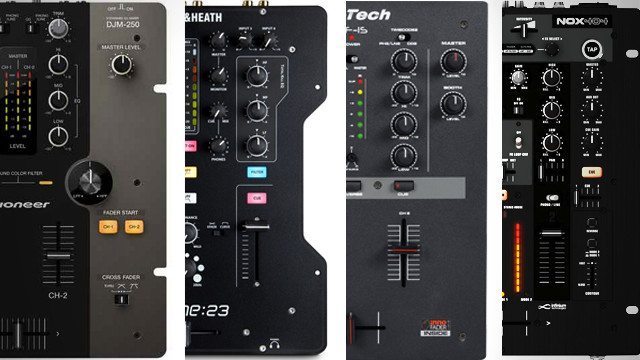Is there a perfect dj mixer for under $300? Back in April, we reached out to our readers to help us identify a selection of dj mixers around that price point which would be most interesting to review as a group. Today, we present the results of that test. We’ve gathered dj mixers from Allen & Heath, Pioneer, DJ-Tech, and Behringer—all of which can be found in stores for around $300 or less—to help you make that choice perfect budget-mixer choice.
BASIC DJ MIXER ROUNDUP
Looking for more advance Dj mixers? Here is our review of the DJM-900. Also check out the Xone D mixers which are great for techno and house
In the following article we have reviewed 4 great basic dj mixers including:
- DJM-250 – (Clean, Reliable Dj Mixer with great filters) – $349
- Allen and Heath Xone 23 – (4 inputs in a 2 channel form factor) – $299
- Dj Tech DIF-1S (Qbert’s highly affordable scratch mixer for the masses) – $199
- Behringer NOX404 (High end features at a low price) – $199
PIONEER DJM-250 MIXER
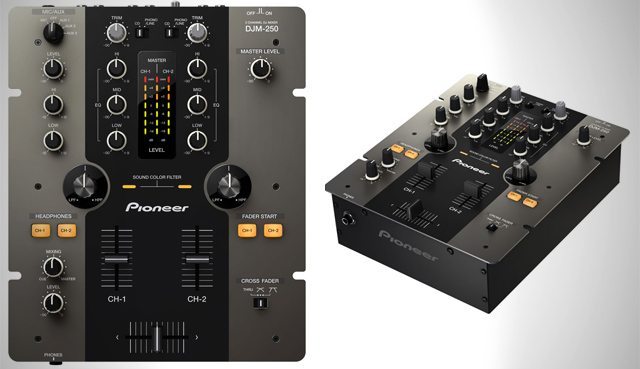
The Good: Clean sound and high level of build quality; great filters; the most inputs of any mixer on test
The Bad: Not much in the way of ‘exciting’ features; limited outputs
The Bottom Line: A solid all-arounder which will adapt to many DJ styles and environments
The lowest priced mixer in the Pioneer range, the DJM-250 definitely has DNA in common with its far more expensive family members. The feel and styling will be immediately familiar to any DJ who’s used a Pioneer mixer from the DJM-500 onwards, and build features like metal pot shafts inspire confidence. The faders are only ‘standard’ ones, but smooth to use, with a light feel, and the crossfader is switchable from a smooth fade to a sharp cut, with the cut-in distance comparable to bigger mixers like the DJM-800.
A huge selection of inputs, including switchable phono/line inputs on the channels, plus three Aux inputs, means you could potentially have a massive seven line-level sources, plus a mic, hooked up to the mixer simultaneously. That makes it perfect as the basis for a bedroom or basement studio setup, where you might want to hook up, say, your TV, your games console, or set-top boxes into your soundsystem, too.
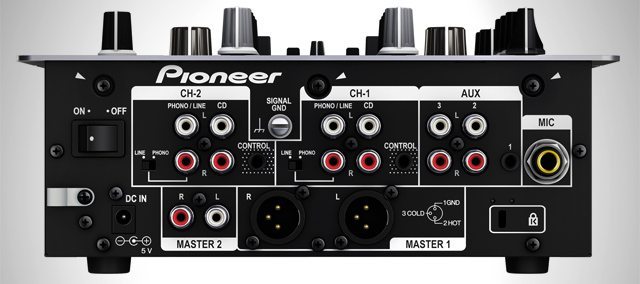
The mixer is suitable for taking out to gigs, too, though, as it features professional XLR balanced outputs, and a nice loud cue output. Only the lack of a monitor output, or even a separate record output, lets the connections down, although the master cueing level is unrelated to the actual master output control—a feature I’d love to see added to Pioneer’s top-flight mixers. Everything feels solidly put together, and sound quality is good.
The DJM-250 is a perfect example of a ‘simple’ option at this budget. No crazy features to get excited about, although the filters on each channel are excellent, and hugely playable, but a perfect balance between quality and price. I’d have no problem recommending the Pioneer to anyone; it’s a completely safe, but not the most exciting, choice. As I use Pioneer mixers at all my residencies (when I can’t take my Z2), I felt right at home on the 250, and that kind of comfort level can’t be overlooked if you’re at the stage of DJing where you’re getting regular gigs.
ALLEN & HEATH XONE:23 DJ MIXER
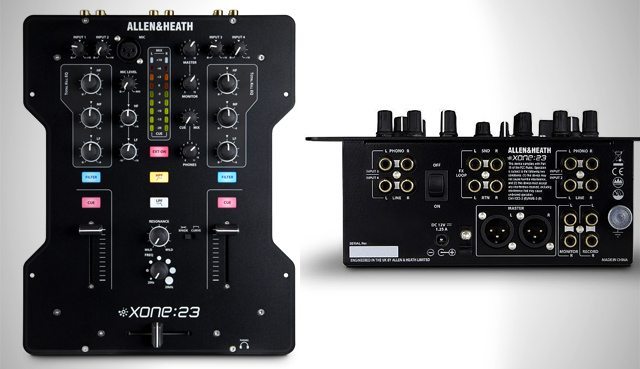
The Good: Sound quality is amazing; built like a tank; excellent Xone filters
The Bad: Crossfader is disappointing; Send & Return loop is not suitable for the most popular FX units; limited inputs
The Bottom Line: Beautifully made with incredible sound, but a few design quirks which might not work for everyone
The Xone:23 feels like a much more expensive mixer than its current $300 street price would suggest. The build quality is impeccable, and the sound quality is simply astonishing. The renowned A&H filters are present and correct, and sound as good as ever, with no clicking or popping when you assign them. The crossover points on the full-kill EQs are perfectly judged, too. Anyone into long blends and smooth mixing will have a great time with this mixer.
In those respects, the Xone:23 follows in the fine traditions of every Xone mixer produced to date. That means anyone who has felt love for Allen & Heath mixers in the past will be delighted with it. Unfortunately the quirks of the range have made their way into the this model as well.
With the honorable exception of the Penny & Giles fader on the Xone:02, I’ve found every Xone crossfader I’ve used to be somewhat underwhelming. The Xone:23’s is distinctly odd—on the smooth, blend curve setting, it fades nicely but all sound is cut out at least half an inch before the end of the fader’s travel. On the sharp, scratch setting, it cuts reasonably sharply, but the cut-in distance is by far the largest of any mixer in this group. A&H do mention the possibility of upgrading to an Innofader, but the 23 is already the most expensive mixer in the test, so I can’t judge it on that basis.
The assignable, post-fader send & return loop for FX is a great feature, in theory, but has one big shortcoming—it doesn’t work properly with Pioneer’s RMX or EFX units, because those are designed to work in an ‘insert’ fashion, as opposed to A&H’s send & return bus. Now, I understand that A&H and Pioneer are mortal enemies in the mixer business, but I don’t think anyone could seriously argue that Pioneer’s effects units are not the most popular with DJs around the world. It also won’t work with send FX in Traktor or Serato DJ. So to have an FX loop which just doesn’t work with those setups means that many potential users of the 23 might immediately be put off. It’s a shame, because it’s well implemented in every other way.
The only other potential issue with the Xone:23 is the lack of inputs. The idea of a pair of inputs on each channel, each with its own gain control, is a good one, but restricting those inputs to two line and two phono inputs, for the mixer in total, is just too limiting for many modern digital setups. You can open up the mixer and remove some resistors to convert the phono inputs to line level, but that’s hardly a trivial job (A&H suggest that you’ll potentially void your warranty in doing so, even), and nothing like as flexible as having a simple switch to go between phono and line level, just as all the other mixers here do. The output section is not so threadbare, with a full complement of XLR master, record, and separate booth outputs; nothing to fault there.
It’s always seemed to me that Xones are very polarizing mixers; some people absolutely adore them, and for good reasons: The sound and the build are superb. But others, and I have to include myself in this group, just can’t seem to get on with the way they work. If you’re a Xone fan, the 23 will rock your world in a big way. But I had hoped this would also be the Xone that finally converted me to the A&H way, too, and sadly it just doesn’t quite manage that.
DJ-TECH DIF-1S SCRATCH MIXER
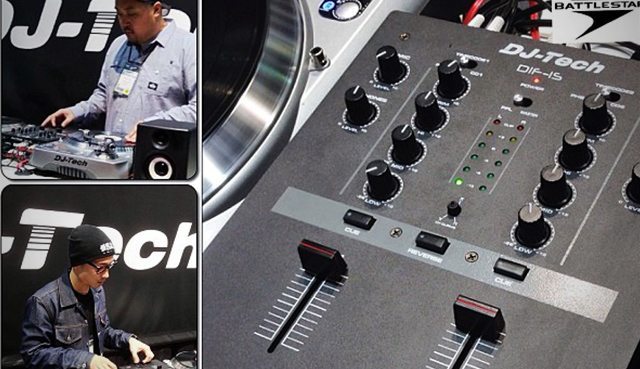
The Good: Fantastic crossfader; flexible inputs and DVS hookup system; great build quality for the money
The Bad: No balanced outputs; lack of master cueing could be a problem for the target market
The Bottom Line: One of the best faders in the game, combined with great build quality for its price; perfect for aspiring turntablists
With the rise of China as a superpower in all areas of manufacturing, it was only a matter of time before we started to see some interesting new takes on DJ technology emerging from that country. DJ-Tech are very much leading the charge, and the DIF-1S was a product that really caught the attention of the DJ world when it was revealed in 2012.
What’s great about the mixer is the purity of its mission—a great crossfader, in a solid but basic box, at a cheap price. Taken on those terms, it absolutely succeeds.
This is a mixer designed for cutting, pure and simple—and having garnered the approval of DJ QBert (who released a special Thud Rumble edition of the DIF-1S last year), you can be assured it’s up to that job very nicely. It’s got a Mini Innofader crossfader that comes standard, with reverse switch and continuous curve control. I’m now very familiar with the Mini Innofader, with one in my Kontrol Z2, and, since reviewing the PNP version for DJTT, having picked one up for my DJM-700. It’s a superb fader—end of story.
…But of course there is a bit more to talk about than just that fader; the rest of the mixer mustn’t be overlooked. The build quality is remarkably good for the cost—it has a street price of around $200, only twenty bucks more than the cheapest mixer in the test. The upfaders are nothing like the crossfader, and have no curve control, but good enough for blending. It’s heavy, has metal pots, and everything feels chunky and solid. Even pulling off the knobs to examine those pots was challenging; the DIF-1S is indeed a well put-together mixer, and any product which aspires to being adopted by turntablists needs to take a beating.
The sound quality is clean—no complaints on that front. It doesn’t approach the majesty of the Xone:23 sound, but is certainly on a par with the other mixers on test. The EQs cut to -26 dB—not a full kill, but not far off—and the cutoff points seem tailored nicely towards scratching, to my ears. What the mixer does lack is much in the way of professional outputs—there is a booth control, but both that and the master are only on RCA phono connectors. So no balanced outputs here, but it’s good to have two outputs, with independent level adjustment, at least, for recording mixes at home.
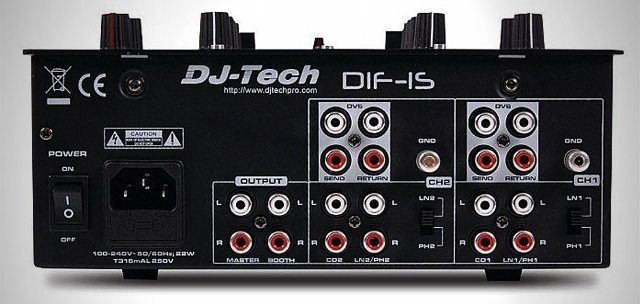
The DVS connections are nicely implemented; it’s basically a send/return insert loop for each channel, which sends the switchable phono/line input out to your DVS soundcard, then back in again on a separate input. What that means in practice is that you can leave your decks/CDJs hooked up to the mixer all the time at home, and patch your soundcard in or out very quickly, if you need to take that out to gig with. If you don’t use it for that purpose, it can be repurposed as just a regular line-level input, meaning you can have up to six sources (in total) hooked up to the mixer at once.
There is one oversight in the design of the DIF-1S which it must lose marks for, and that’s the cueing. Limited to a simple cue on/off for each channel, the lack of any ability to listen to the master output in the headphones is a big no-no on any mixer aimed at turntablists. Precious few parents/neighbors/significant others will cope with hearing the constant wiki-wiki of a turntablist in training for very long, and so having no master cue function could prove to be a deal-breaker in many households. There are workarounds, of course—I used to practice by connecting my headphones to my amp, back in the day—and it looks like DJ-Tech have listened to customer feedback, as their new DIF-1M does indeed feature master cue facility. But while that is something that you might need to consider when it comes to the DIF-1S, it’s the only real flaw in what is otherwise a very impressive mixer for $200.
BEHRINGER NOX404 DJ MIXER
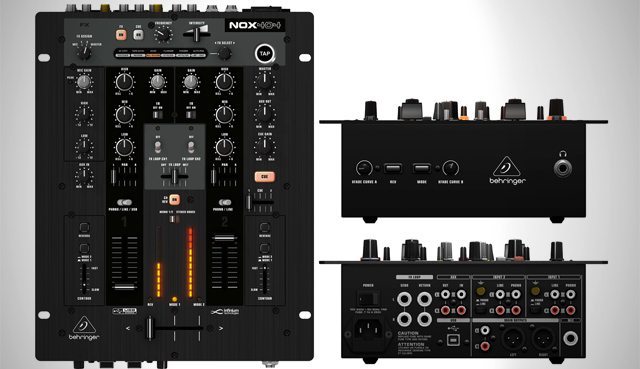
The Good: Insane amount of features, many of which are really fun; excellent crossfader; USB connection is a nice addition
The Bad: Build quality not quite as high as the other mixers on test; some odd layout choices
The Bottom Line: A hugely fun and very flexible mixer, only let down by the slightly cheap feel of its construction
The last Behringer mixer I spent any serious time with was one of their old VMX series, a long time ago, and I must admit, even by the standards of the era, that was pretty poor. But I’ve watched with interest as Behringer have continued to refine their DJ kit as the years have gone by, with the DDM-4000 gaining many fans, and now the NOX series getting a lot of love from DJ TechTools readers in the comments on our preview to this review.
And having spent time with the NOX404, I can see why. This mixer is FUN. It has more features than any other mixer here—optical crossfader, USB soundcard, assignable send/return loop, built-in FX, adjustable curves on all faders, pan controls—with simply a ton of ways to interestingly interact with your music. For the $180 street price, this mixer’s feature count is simply astonishing.
Inputs and outputs are fully covered. You’ve got master output of XLR and RCA phono connectors. An Aux output with its own level control. Line and switchable line/phono inputs on both channels, plus an aux input, mic, and the send/return loop is on 6.35 mm jacks. Not much more you could ask for…
…Except maybe a USB port. The only mixer on test to have any digital hookup, the soundcard on the NOX404 is pretty basic, but still useful regardless. Offering a single stereo stream in and out of your computer means recording your sets is as simple as connecting up the USB lead and choosing the right input in your recording software. Plus, you can play audio back to the mixer by switching channel A over to the USB input. No, you won’t be assembling a full DVS system with the soundcard in the 404, but it works very nicely, and it’ll certainly be a huge step up from plugging a 3.5 mm jack into your computer’s onboard sound for recording.
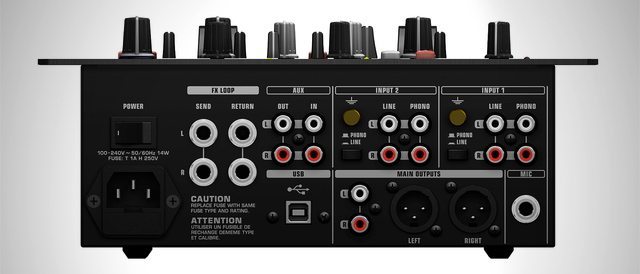
The crossfader is of the optical variety: An Infinium fader. Having spent some time with it on the Mackie d.2 mixer, I know it’s a superb fader, up there with the Mini Innofader found in the DIF-1S, really; it even offers tension control, which the Mini doesn’t have. Full curve controls on the upfaders might also sway aspiring turntablists towards the NOX404, as will the ability to cue the master output in the headphones.
The FX section is a mixed bag—some sound great, others not so much. I’m willing to bet any DJ will find something in there they could make regular use of, though. For me, the FX that don’t rely on beat syncing work best, as getting an accurate BPM into the mixer is not as simple as it could be—you always have to do it manually. The FX aren’t post-fader, meaning no echo tails, etc., but the send/return loop is, and because it has a wet/dry control, it can work with pretty much any unit out there, including the Pioneer range. The only downside is the slight audible popping when you engage the loop on either channel. It can be worked around, but it’s there.
With so much going on, faceplate real-estate is at a premium, and to be honest I could have done without the fader Mode switches, which seem a bit superfluous. The same goes for the pan faders, which I guess could be useful for some, but their positioning right below the bass EQ knobs could be an issue.
Of course, Behringer might be supply-chain masters, but they are not magicians, and there has to be a price to pay for all that functionality in a sub-$200 mixer. Whilst the sound quality is perfectly respectable, the build quality of the 404 just doesn’t feel quite as reassuring as the other mixers here. The pots are plastic, and all exhibit varying degrees of wobbliness—the cue level knob on our review unit, especially so; the mixer was also missing one of its rubber feet. The buttons, likewise, all feel a bit plasticky. Now, to their credit, Behringer do offer an excellent warranty: three years for the mixer as a whole, and a year for pots and faders, etc. So I think you can buy with confidence, but I’m pretty sure that in five years, a DIF-1S will be in better shape than a NOX404 bought at the same time.
WRAP-UP
I was kind of hoping that there would be a real standout product in this group test—one budget mixer to rule them all. That’s not the case, but I’m not disappointed by that in the end. When I think back to some of the mixers in this price range when I started out, it’s clear that we’ve never had it so good as we do today.
It’s almost unfair to compare the Xone:23 and the DJM-250 against the other two mixers. Yes, the price difference is only $100, but proportionally, thats huge at this price range, and you can feel every cent of those extra dollars. Both of our $300 mixers are very well built, with good/great sound—perfect, indeed, for a DJ’s first real upgrade after outgrowing their initial basic kit.
Of those two, my choice would be the Pioneer. It works better for me in terms of the way I DJ, and with the kind of kit I use (I’d have to run my RMX-1000 on the master output of either, so that’s not a consideration). But even amongst the circle of DJs I spin with, there are many for whom the Allen & Heath will be absolute mixing nirvana. Hopefully, by the time you’re ready to drop $300 on a mixer, you’ll have an idea of your own style and needs, and neither of them will disappoint if you choose the right one.
Down around $200, well under the limit of our budget, we see two wildly different takes on what a budget mixer can be. The NOX404 is an all-singing, all-dancing powerhouse of a mixer, which will adjust to pretty much any style of DJing. It’s massively fun to use, with only my doubts about its potential longevity casting a shadow over the proceedings.
The DIF-1S is a pretty unique proposition; a dope crossfader in a big solid box. The rest of the mixer is a touch uninspiring feature-wise, but certainly feels like it will take a beating. The lack of a master cue is disappointing, but not the end of the world. This is the first DJ-Tech product I’ve tried for any length of time, and it makes me excited to see what they come up with in future.
If it were my $200? Well, I’m not a hardcore, proper turntablist, and the NOX404 has a great crossfader, too. Plus, I’m the kind of person who loves shiny things, and crazy features, so if I were a beginner today, I’d buy the Behringer. I wouldn’t necessarily be expecting to pass it down to my grandkids, but I’d sure have a lot of fun in the meantime.
Please support DJ TechTools editorial by checking out our selection of DJ mixers in the store!


